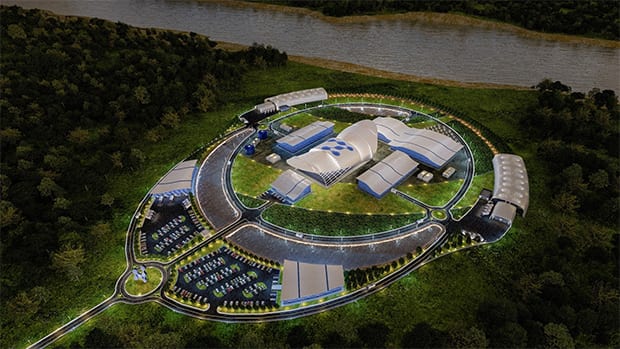Group to Cities: Get Out of Nuclear Project While You Can
The Utah Taxpayers Association has urged cities and towns that have subscribed to the Utah Associated Municipal Power Systems (UAMPS) small modular reactor (SMR) project to withdraw from the venture before a Sept. 14 deadline that would lock them into a share of billions of dollars in costs associated with the undertaking.
Rusty Cannon, vice president of the Utah Taxpayers Association, suggested city and town councils would be making a huge mistake to proceed with the SMR project. “The evidence the Utah Taxpayers Association has examined provides a bleak picture of the massive high-risk financial commitments these cities will need to make long into the future. The proposal carries the likely potential for delays and cost overruns on unproven technology that continues to be less and less competitive than other clean energy alternatives,” he said during a media call on Aug. 4.
UAMPS’s Carbon-Free Power Project
UAMPS is a political subdivision of the state of Utah. It provides comprehensive wholesale electricity, on a nonprofit basis, to 47 members—mostly municipalities—in six states: Utah, California, Idaho, Nevada, New Mexico, and Wyoming. UAMPS formally launched its Carbon-Free Power Project (CFPP) in 2015 as part of a long-term strategy to reduce carbon emissions and replace aging coal-fired plants.
The project involves constructing an SMR power plant (Figure 1) on the U.S. Department of Energy’s (DOE’s) 890-square-mile complex west of Idaho Falls, Idaho. The site currently houses Idaho National Laboratory’s (INL’s) research facilities; the Idaho Cleanup Project’s legacy waste cleanup operations; and the Defense Department’s Naval Reactors Facility. The SMR project would be constructed with technology being developed by NuScale Power, which is headquartered in Portland, Oregon. The proposed facility would have 12 modules with an electrical output of 60 MW each.

As part of the project, INL experts helped select the location for the proposed SMR plant. INL is also assisting with other technical aspects, including modeling and simulation of SMR components and systems, among other things. Other entities involved in the project include Energy Northwest, Fluor Corp., and the Tennessee Valley Authority (TVA).
Energy Northwest is a Washington state public power agency that owns and operates the Columbia nuclear plant in Richland, Washington. Energy Northwest will have the option to operate the CFPP for UAMPS, if the plant is constructed. Fluor Corp. is the majority investor in NuScale and is involved in SMR commercialization efforts. The company also manages the Idaho Cleanup Project waste remediation work overseen by DOE’s Office of Environmental Management through the DOE-Idaho Operations Office.
TVA—a corporate agency of the U.S. that provides electricity for business customers and local power distributors serving about 9 million people in parts of seven southeastern states—is also pursuing an early site permit for SMRs at its Clinch River nuclear site. UAMPS and TVA are planning to work together with the DOE to develop the “standard content” portions of a Combined License Application, which the U.S. Nuclear Regulatory Commission (NRC) must authorize to construct and operate a nuclear power plant. TVA, which has significant knowledge and experience operating large nuclear plants, would presumably help to ensure a high-quality license application is submitted.
Nuclear Project Is Potentially Costly for Small Cities
According to the NuScale and INL websites, the Idaho-sited SMR plant could be fully operational by 2027. However, that seems like a lofty goal based on the history of first-of-a-kind nuclear projects.
“The development of untried new designs is no place for small utilities with no nuclear construction experience to risk their customers’ money,” Peter Bradford, a former NRC commissioner who has served as chair of both the New York Public Service Commission and the Maine Public Utilities Commission, said during the Aug. 4 media call. Bradford has been an expert witness in many cases involving nuclear power economics.
According to the Utah Taxpayers Association, a total of 34 municipalities—none with populations larger than 100,000 people—are participating in the UAMPS SMR project. The group said ratepayers will be locked into more than $100 million in commitments on Sept. 14, and billions of dollars of risks later on, if they don’t opt out of the project.
Cannon said cities entered into an agreement when the project began that requires subscribers to affirmatively vote to withdraw from the project at several “off ramps,” otherwise, they’re contractually obligated to continue with the project. “These municipalities are currently in an off-ramp period,” he said.
Cities subscribed to the project have sunk about $9 million into the project to date, according to Cannon. “The next step, which constitutes obtaining approval for the design of the reactors and acquiring a license, is projected to cost UAMPS members approximately $19.9 million more,” he said.
“But the risks only become worse from there. This approval section of the first phase is scheduled to take until approximately May of 2023. At that time, the project would enter the next phase—licensing—which is projected to last until November of 2025. So, projected costs for UAMPS members for that phase is an additional $658.4 million,” Cannon said.
“We think committing cities to that much money on a project that is still untested; has not gained approval from the Nuclear Regulatory Commission, or NRC; [and] relies heavily on annual appropriations from the federal government to the tune of billions of dollars to even approach the point of making this work through any financial sense is the wrong move and could put ratepayers and taxpayers on the hook for massive sunk costs for decades to come,” Cannon said. “The money spent on the project so far pales in comparison to what cities would be signing up for next.”
—Aaron Larson is POWER’s executive editor (@AaronL_Power, @POWERmagazine).